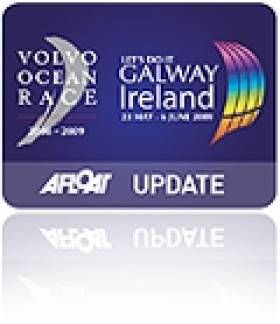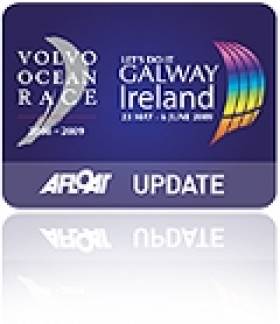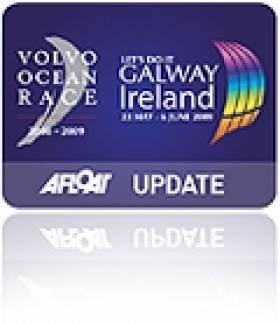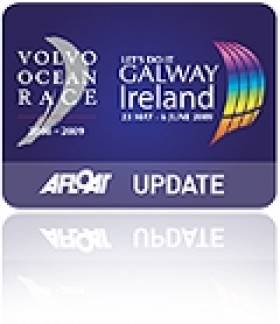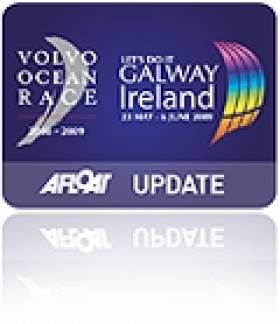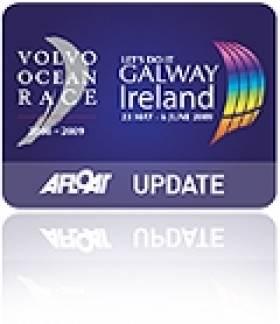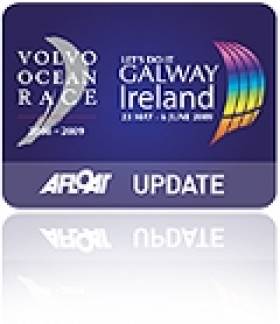Displaying items by tag: Ocean
Marine Minister Showcases Galway at Volvo Race Start
#VOLVO OCEAN RACE – As the Volvo Ocean Race 2011-2012 kicks off tomorrow (5 November) from Alicante in Spain, Minister for Agriculture, Marine and Food Simon Coveney TD joined Tourism Ireland today, at a reception for key Spanish and international media contacts. As previously reported by Afloat.ie this week the event, which took place in the Volvo Ocean Race Village in Alicante, was an excellent opportunity to showcase Galway and Ireland as a fantastic holiday destination, kicking off Tourism Ireland's publicity drive around the world during the nine-month race to reach a huge audience of potential holidaymakers.
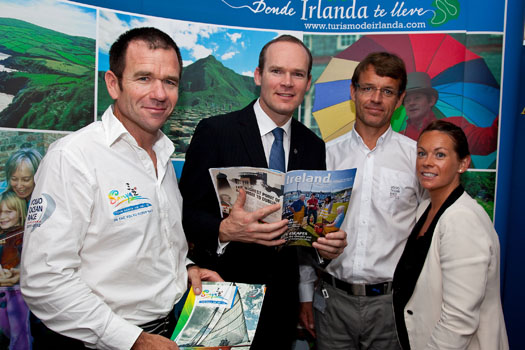
Mike Sanderson, skipper of Team Sanya, the Chinese/Irish boat; Simon Coveney TD, Minister for Agriculture, Marine and Food; Knut Frostad, CEO of the Volvo Ocean Race; and Barbara Wood, Tourism Ireland's manager in Spain, at the Tourism Ireland reception in Alicante, prior to the departure of the Volvo Ocean Race 2011-12 tomorrow
The Volvo Ocean Race attracts huge publicity around the world – with billions of people around the globe seeing it on TV, reading about it and tuning in to hear about it on the radio. Over the coming months, Tourism Ireland will be working in key markets where the race stops, to ensure that Galway and Ireland are in the spotlight.
Niall Gibbons said: "The Volvo Ocean Race attracts huge publicity around the world and with Galway due to host the grand finale, there's an ideal opportunity to showcase Galway and the west, and the many attractions that the island of Ireland has to offer as a holiday destination. The event is a great 'hook' for Tourism Ireland to reach a huge audience of potential holidaymakers."
Galway will host the final stopover of the Volvo Ocean Race 2011-2012 in July of next year. The 2009 stopover of the Volvo Ocean Race in Galway brought 40,500 international visitors to the city, as well as 269 journalists from around the world.
Volvo Ocean Race to Start in Alicante Again in 2014
# VOLVO OCEAN RACE The 12th edition of the Volvo Ocean Race will take place in 2014-15, starting once again in Alicante, after Volvo Car Corporation and Volvo Group reaffirmed their long-term commitment to the world's premier offshore sailing event but there is so far no news of the next course, other port stop overs or if the race will end in Galway in 2015.
Stefan Jacoby, CEO and President of Volvo Car Corporation, Olof Persson, CEO and President of Volvo Group and Knut Frostad, CEOof the Volvo Ocean Race. PAUL TODD/Volvo Ocean Race
"At a time when many sports events are struggling to survive in one of the toughest economic climates in living memory, the future of the Volvo Ocean Race is looking very healthy." - Volvo Ocean Race CEO Knut Frostad
Volvo Ocean Race CEO Knut Frostad announced the broad timetable just as the fleet prepared for the start of the 2011-12 edition in the Spanish port.
Flanked by Volvo Car Corporation CEO Stefan Jacoby and Volvo Group CEO Olof Persson, Frostad said the next race would begin in the autumn of 2014 in Alicante, where the race has been based since 2010.
Frostad's announcement came after the Volvo Ocean Race revealed that a record 66 broadcasters around the world have so far signed up to follow the 11th edition, reaching 550 million households.
"Right now, I'm concentrating on 2011-12 which I believe will be the most thrilling we've ever had," Frostad said. "I'm just excited that this race just keeps getting better and better in every aspect.
"We intend to bring the drama of a race which stretches its competitors to breaking point day in day out to a far bigger audience than ever before. We believe we will win new converts to this great sport of ours with our coverage."
Wild Salmon Showing Signs of Adapting to Climate Change
New evidence is indicating that wild salmon are adapting to climate change by feeding in colder waters, The Irish Times reports.
According to salmon expert Dr Ken Whelan, wild salmon are now diving as far as 800m below the surface - normally the preserve of the sperm whale - to feed for periods of up to 24 hours during winter months.
They are also travelling closer to the polar ice fields, in response to the warming of the Atlantic Ocean.
The change in behaviour was noted at a salmon summit in France attended by more than 100 fishery managers and scientists from across Europe, which was convened to discuss the threat of climate change to wild salmon stocks at sea.
Plankton levels are particularly affected by the changing wind and ocean currents, said Dr Whelan of findings from the EU-funded Salsea programme, which he led.
“Surviving the first winter at sea seems to be the key challenge for these stocks, and the salmon in the northern states like Norway and Russia, seems to be less affected,” he said.
But the recent return of wild salmon to the Tolka in Dublin, as well as healthy numbers along other inland waterways, highlighted that the news was not all doom and gloom.
The Irish Times has more on the story HERE.
New Media Man Announced for Discover Ireland Backed VOR Entry
Team Sanya, the Chinese - Irish backed entry in the 2011/12 Volvo Ocean Race, announced today that Andres Soriano (ESP/USA) is to take on the role of their Media Crew Member.
There has been some disappointment at home given the only Irish crew member on board the boat was Frankie Leonard who withdrew over seasickness in late September. Subsequent applications for the media post included Irish sailors who it now appears were unsuccessful in their quest to join Mike Sanderson on the Sanya boat, 25% funded by Discover Ireland.
Andres started working with Team Sanya as part of the Shore Team back in August 2011 when the team was based in the UK. Since then he has developed a close fit with the team and has gained a detailed understanding of the team objectives as well as the workings of the race boat. These facts, combined with Andres' media background and
experience, puts him in a perfect position to take on this role and deliver great results for the team and the event.
Mike Sanderson, CEO/Skipper for Team Sanya, commented on today's announcement:
" Since day one, Andres has fitted in perfectly with our team spirit and personality. He is an incredibly hard worker and has turned his hand to anything we have thrown at him, which has won him enormous respect from the guys. He has the right balance of media skills and creativity coupled with offshore sailing experience and so I have high hopes for his ability to tell the Team Sanya story to the outside world in a dynamic and unique manner." Andres Soriano, new Media Crew Member for Team Sanya, gave his reaction
to his new role:
"I am truly ecstatic and excited about my role as media crew member. I know it will be one hell of a ride and I consider myself very lucky to be a part of this awesome Team Sanya race crew. We have already built up a keen fan base and I will definitely take on the challenge to expand that by telling our story in an insightful way never seen before."
Andres Soriano Biography details:
Date of Birth : March 26th 1986
Nationality : Spanish American
Resident : Manila, Philippines/New York, USA
Sea Sickness Rules Irish Sailor Out of World Race
Galway sailor Frankie Leonard is stepping down as Team Sanya's media crew-member following a bout of seasickness in the recent 2,000-mile qualifying passage for the Volvo Ocean Race (VOR).
The team Sanya entry is a Chinese-Irish entry in the race that starts in November from Alicante. Tourism body Discover Ireland are backing the boat and making up 25% of its estimated €10 milion campaign costs. Leonard was the only Irish crew member on the boat that is under Kiwi skipper Mike Sanderson, a former race winner. The boat, one of seven entries, is expected at the race finish in Gawlay next July.
A statement yesterday described the development as a "cruel blow" to both Leonard and the campaign and paid tribute to the cameraman's commitment and contribution.
Much of the MCM role is dependent on being below decks for extended periods, either working in the tight confines or at the galley preparing the freeze-dried food for the crew and is a mandatory position within every team. The team statement is below.
23rd Sept 2011
Mike Sanderson, Team Sanya CEO and Skipper, announced yesterday with regret a change to the media crew member role following a decision to release Frankie Leonard from his duties. Frankie, who has been engaged with the team since the beginning of the project, unfortunately has suffered from seasickness, which affects a great many sailors.
Mike Sanderson commented:
" Frankie has all of the ideal qualities to fit this role - superb teamwork and communication skills, a dynamic approach to his film and photo work combined with a great sense of humour and a pleasure to be around. However, this race is all about performance on the water and Frankie's suffering from seasickness is a cruel blow both to the team and to him. As anyone who been struck down by seasickness knows well, it can leave you incapable of functioning to your normal levels. We have 37,000 miles of ocean to cover and sadly that left me with no option in this matter.
Frankie has made a great contribution to the team and made many new friends in the time he has been here and we will be keeping in touch for sure."
Frankie Leonard added his thoughts:
"It has been an amazing opportunity to be a part of this special team and a great experience both personally and professionally. I am happy to say that I leave with no regrets. It is always unfortunate when things come to an end but rather than dwell on negatives I prefer to accentuate positives. Team Sanya has had one of the highest media outputs of all the teams with almost double some teams output for video, blogs and photos. We have steadily built up good relationships with the media, our sponsors and Volvo Ocean Race HQ, which can only be a positive for the team. I know that the skills, knowledge and experience I have acquired will stand to me as I now go in search of new projects. I am glad to count Mike and my teammates as good friends now and I wish Team Sanya a safe, happy and fast race."
Dublin to Hamble in 24 Hours - Team Sanya's Video
One minute it's trips round the bay with Miss World, canapés at the Royal Irish Yacht Club and corporate hobnobbing in Dun Laoghaire. The next it's a wet and windy ride from Dublin to Hamble in 24 hours. It's the lot of the modern Volvo Ocean Race crew (helmets compulsory). Chinese-Irish race entry Team Sanya boss Mike Sanderson (a previous race winner) has called his exit from Dublin 'heinous'. Don't take our word for it tho, check his vid below:
Rosanna Davison Goes Sailing on Team Sanya (Pics here!)
Former Miss World Rosanna Davison went sailing from Dun Laoghaire today on board the Chinese Volvo Ocean Race Yacht, Team Sanya. The yacht has backing from discover Ireland and is on a promotional day before departing for Alicante and next month's race start. Kiwi Skipper Mike Sanderson showed the local girl the ropes and Photographer Michael Chester sent Afloat.ie back these photos from the high speed spin around Dublin Bay.
Skipper and past race winner Mike Sanderson and his crew - including Galway’s Frankie Leonard – received a special send-off from Rosanna who won her Miss World title in the Chinese city of Sanya in 2003.
Team Sanya is the Chinese entry in the 2011-12 Volvo Ocean Race, a 40,000-mile round the world race that will finish in Galway on the 3rd July 2012. A special relationship developed between Ireland and China during the last race through the Green Dragon entry.
Rosanna boarded the yacht at 11.00am at the Royal Irish Yacht Club and sailed with the team into Dublin Port. The Eastlink bridge was lifted at 2.00pm, and Team Sanya docked beside the Cill Airne.
As part of the team’s promotion and it’s Irish link through the Discover Ireland.com, the 70 foot race boat and crew will head back out into the open sea as they start their journey to Alicante for the race start on the 5th November.
The Volvo Ocean Race is regarded as sailing’s premier global race and one of the most demanding team sports in the world. The 2011-2012 Volvo Ocean Race route is: departing on 5th November from Alicante to Cape Town (South Africa) Abu Dhabi (UAE) Sanya (China) Auckland (New Zealand) Itajai (Brazil) Miami (USA) Lisbon (Portugal) Lorient (Framce) and finally Galway on the 3rd July 2012.
Mike Sanderson, skipper and CEO of Team Sanya commented on the forthcoming trip: “Our relationship with Ireland is really important to us. Frankie Leonard from Galway is our media crew member and he is going to be paramount in telling our story as we race around the world, building the profile of Ireland as the stunning tourist destination that it is. For many of our team, it is our first time visiting Ireland so we were really happy to include a pitstop in Dublin during one of our training trips.”
Frankie Leonard, Team Sanya race team and the Irish Media Crew Member, added: “As the only Irishman on board I’m very proud to be part of this exciting event with Team Sanya and really looking forward to sailing into Dublin next week. My home town is Galway and finishing there in July 2012 is going to be a very special moment but this stop-over is a perfect way to help build a strong following and fan base in Ireland to develop Ireland’s profile as we travel to nine other ports around the world.”
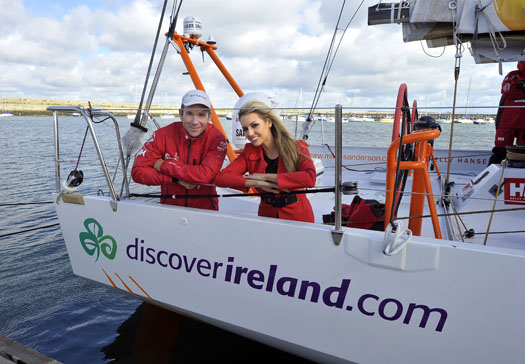
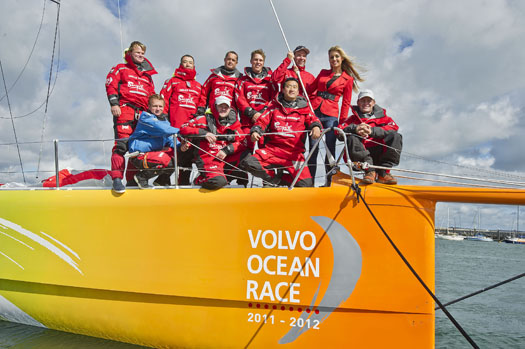

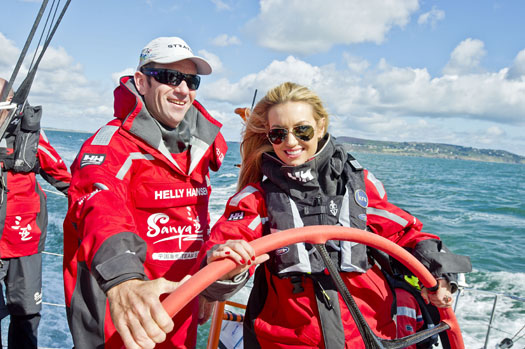
More shots of Team Sanya on Dublin Bay today (by Gareth Craig) here
Rosanna Davison Goes Back to Her Roots Sailing with Team Sanya
Skipper and past race winner Mike Sanderson and his crew - including Galway's Frankie Leonard - will receive a special send-off from Rosanna who won her Miss World title in the Chinese city of Sanya in 2003.
Team Sanya is the Chinese entry in the 2011-12 Volvo Ocean Race, a 40,000-mile round the world race that will finish in Galway on the 3rd July 2012. A special relationship developed between Ireland and China during the last race through the Green Dragon entry, say backers Discover Ireland, the tourism body.
Rosanna will board the yacht at 11.00am at the Royal Irish Yacht Club and will sail with the team into Dublin Port. The Eastlink bridge will lift at 1.00pm, and Team Sanya will dock beside the Cill Airne at 2.00pm. Rosanna will be on the Cill Airne from 5.30-7.00
As part of the team's promotion and it's Irish link through the Discover Ireland.com brand, the race boat and crew will call into Dun Laoghaire on Sunday, 4th September, at 5pm as previously reported on Afloat.ie.
They will overnight in Dublin and sail up the Liffey on Monday at 1pm and dock beside the MV Cill Airne on North Wall Quay, Dublin 1. A reception will be held on the MV Cill Airne from 5-7pm.
At 7pm the Team will head back out into the open sea as they start their journey to Alicante for the race start on the 5th November.
The Volvo Ocean Race is regarded as sailing's premier global race and one of the most demanding team sports in the world. The 2011-2012 Volvo Ocean Race route is: departing on 5th November from Alicante to Cape Town (South Africa) Abu Dhabi (UAE) Sanya (China) Auckland (New Zealand) Itajai (Brazil) Miami (USA) Lisbon (Portugal) Lorient (Framce) and finally Galway on the 3rd July 2012.
Mike Sanderson, skipper and CEO of Team Sanya commented on the forthcoming trip: "Our relationship with Ireland is really important to us. Frankie Leonard from Galway is our media crew member and he is going to be paramount in telling our story as we race around the world, building the profile of Ireland as the stunning tourist destination that it is. For many of our team, it is our first time visiting Ireland so we were really happy to include a pitstop in Dublin during one of our training trips."
Frankie Leonard, Team Sanya race team and the Irish Media Crew Member, added: "As the only Irishman on board I'm very proud to be part of this exciting event with Team Sanya and really looking forward to sailing into Dublin next week. My home town is Galway and finishing there in July 2012 is going to be a very special moment but this stop-over is a perfect way to help build a strong following and fan base in Ireland to develop Ireland's profile as we travel to nine other ports around the world."
Volvo 70 Team Sanya Heading for Dun Laoghaire
The Volvo Ocean Race Chinese entry, Team Sanya, backed by Discover Ireland, is coming to Dublin Bay this Sunday afternoon. She will berth alongside the Royal Irish Yacht Club according to the promoters. At 4pm the Mike Sanderson skippered boat will round a turning mark off Dun Laoghaire harbour before berthing in the port. Team Sanya is a refurbished version of the Telefónica Blue boat from the 2009 race.
Piracy Threat Forces Volvo Ocean Race Route Change
The escalating piracy problem in the Indian Ocean has forced organisers of the Volvo Ocean Race 2011-12 to redraw the routes for the second and third legs.
The boats were due to have sailed through an East African corridor in the Indian Ocean on the second leg from Cape Town to Abu Dhabi and again in the third leg from Abu Dhabi to Sanya in China but after taking advice from marine safety experts and the sport's governing body, the International Sailing Federation (ISAF), the routes have been changed.
The boats will now race from Cape Town to an undisclosed 'safe haven' port, be transported closer to Abu Dhabi, and then complete the leg from there. The process will be reversed for the third leg before the race continues on to Sanya.
"This has been an incredibly difficult decision," said Volvo Ocean Race Chief Executive Knut Frostad. "We have consulted leading naval and commercial intelligence experts and their advice could not have been clearer: 'Do not risk it.'
"The solution we have found means our boats will still be racing into Abu Dhabi and competing in the in-port race there.
"Abu Dhabi is a very important part of our plans, a real highlight being the race's first-ever stopover in the Middle East, and we will now have a really exciting sprint finish to the emirate over the New Year period as well."
Abu Dhabi will host the race from December 30 to January 14 with a purpose-built race village at its Corniche waterfront site and a headline New Year's Eve concert amongst various festivities set to provide a spectacular welcome to more than 100,000 visitors.
"The measures taken by the Volvo Ocean Race are very much in line with the advice that the International Sailing Federation has been giving for some time." said ISAF Secretary General Jerome Pels. "The ISAF strongly urges all yacht skippers intent on sailing anywhere in the area to seek an alternative, which the Volvo Ocean Race is now providing."




























